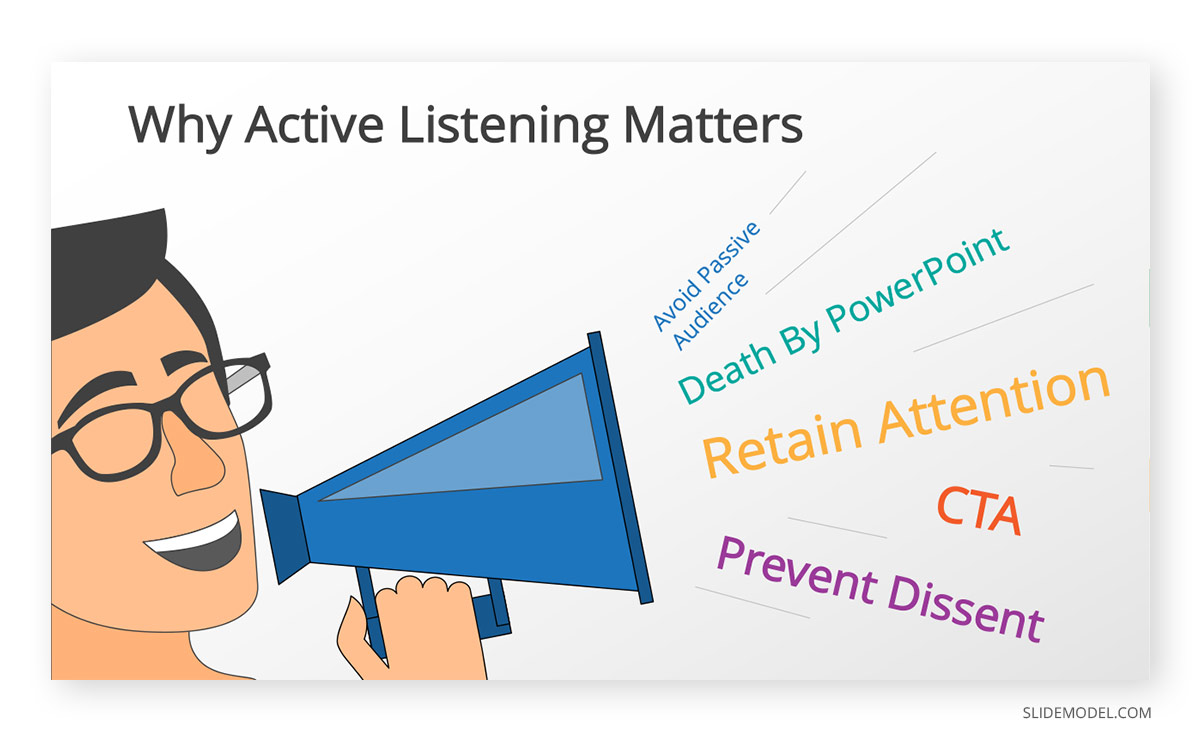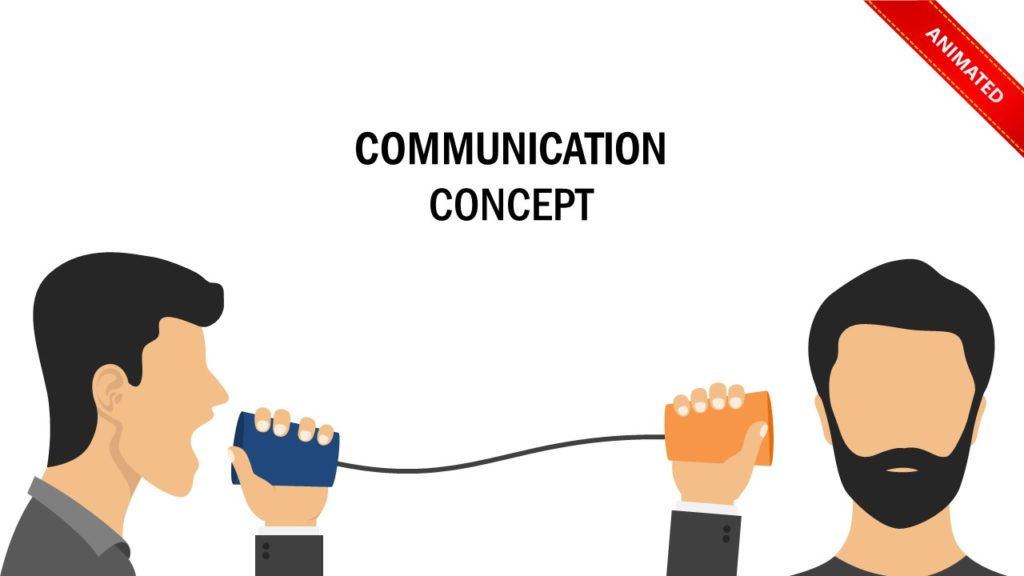
As a presenter, one of the hardest things to master is to engage your audience in a manner that focuses on your message, absorbs the information, and responds thoughtfully. In the era of smartphones and short attention spans, engaging your audience can be harder than ever. But not impossible! To understand how to reach out to your audience, you need to make them actively listen to your message. In other words, you need to understand and master the art of active listening and use it to engage your audience.
What is Active Listening?
Active listening involves the listener carefully understand, remember and thoughtfully respond to what they have heard. The technique of active listening entails conducting engaging conversations without judgment. Active listening can help individuals objectively understand the information and respond after carefully considering the context and non-verbal cues. The latter might include cues such as the pitch of someone’s voice or body language.
Active listening is a soft skill that is common in different professions. Some examples of active listening include people delivering training, conducting counseling sessions, or involved in dispute resolution. However, that’s not to say that the technique is limited to a few professions only. Active listening is one of the most prized skills that can also help you in your career and personal life. The implications of active listening can even go beyond one individual, as it can be great for supporting two-way communication. Such as during a presentation session when a presenter is looking to engage an audience actively.

Main Components of Active Listening
Since active listening involves considering both the verbal and non-verbal cues, the main components of the technique require carefully considering the context, mood, remembering the message, and responding to it accordingly. The main components of active listening require an individual to actively comprehend, retain and respond to what is being said.
Comprehend
Comprehension is the first step towards understanding the speaker. This involves taking into account both verbal and non-verbal cues to understand the message. As a speaker, it´s important to constantly check for understanding and ask probing questions to the audience to reveal if the message is coming across correctly.
Retain
It is only natural that the listener will forget what is being said as the conversation or presentation moves forward. This is why the listener needs to retain information by note-taking or retaining the gist of the message. Creating a PowerPoint presentation that can later be distributed or even shared in advance can be helpful for the audience.
Respond
Responding is the process of carefully replying to what is being said. This validates the speaker in what would otherwise be a passive conversation. Encouraging further communication, especially if the response is empathetic, can also be an active part of clear comprehension from both parties.

3 As of Active Listening
The 3 As of active listening include attention, attitude, and adjustment. If you are looking to enhance your active listening skills, you need to focus on these three aspects. Understanding them will also enable you to help engage your audience.
1. Attention
When it comes to barriers that prevent someone from being an active listener, attention plays a major role. Many people complain about being unable to sit through a 2-minute YouTube video, let alone a lengthy PowerPoint presentation. Enhancing your attention and focusing on the message is the first A of actively listening to a conversation.
Using Attention as a Presenter: As a presenter, you can reduce distractions by asking your audience to avoid interruptions from email or notifications on their smartphones. Alternatively, you can make them actively engage in your presentation by allowing them to view your slides on their handheld devices using a shared link. PowerPoint has a built-in feature called Office Presentation Service that is accessible from the Slide Show tab. It enables online sharing of your presentation slides. There are also third-party services that can be used to engage your audience with polls, quizzes, and feedback options.
2. Attitude
Passive conversations often result in people missing a lot of non-verbal cues. On the contrary, active listening entails understanding these cues to understand better what is being discussed. Your attitude towards a conversation determines whether you can actively understand the conversation or have psychological deaf spots preventing you from being an active listener. People who might consider the conversation ‘a waste of their time’ would find it hard to make the conversation meaningful.
Shaping the Attitude of your Audience: As a presenter, you will have to shape the attitude of your audience by showing them why the presentation is worth their time. Please don’t wait too long before reaching out to your audience, or they might end up with the wrong attitude towards your presentation. You must start with an impact, grab audience attention and ensure you have something they might find valuable. For example, a pitch deck that drags on how great your company or idea is likely to fall on deaf ears. The potential investors need to know how the venture might be worth their money and the Return on Investment (ROI) for them.
3. Adjustment
When listening to someone, we don’t know what the other person would say. This means that we need to be flexible, considerate, and patient to listen to the speaker actively. Putting aside personal biases and judgment. Enabling the speaker to complete their side of the message without interrupting them due to a negative attitude.
Adjusting Your Presentation: Presenters can often end up with at least a part of the audience that will never be satisfied with their presentation. You might also come across people looking to intimidate you because of their habit of being trouble mongers. In such a case, you need to be flexible as a presenter to enable your audience to give you the same leverage. Enabling you to engage people actively when listening to you. You can learn more about how to do this from our previous article about the importance of understanding the 20/60/20 Rule to engage your audience.

Why Active Listening Matters in a Presentation
Active listening has immense importance for presenters. This not only includes listening and responding to your audience effectively but also ensuring that your audience actively listens to you.
To Avoid Death by PowerPoint
Death by PowerPoint is a common phenomenon where text-heavy slides and boring presentations lead to uninterested, passive listeners. Therefore, active listening is essential to avoid this conundrum and deliver a presentation that remains meaningful and encourages call-to-action.
To Retain Audience Attention
Carrying a conversation forward is a two-way street. You need to not only speak but ensure that your audience is heard and their opinion valued. Two-way active listening is important to ensure you can retain audience’s attention during a presentation.
Keeping the audience’s attention is important in any presentation, as losing their focus can lead to them tuning out or becoming distracted. This can be done by using engaging visuals and stories, keeping your speech concise and on-point, and avoiding unnecessary distractions.
To Prevent a Passive Audience Response
No presenter wants to deliver a pitch deck that results in zero investor interest or a presentation at the workplace that yields no positive response from colleagues. By being an active listener and engaging your audience, you can prevent a passive response and turn it into something positive and meaningful.
To Prevent and Placate Dissent
Some would say that it is easier to step on a cultural minefield to offend someone than to remain likable by most people. Be it the ‘woke culture’ or the need to cater for multiculturalism. You need a group of active listeners to ensure your message isn’t taken the wrong way due to a miscommunication or that you can placate dissent by adjusting your tone.
To Encourage Call-to-Action
Most presentations come with some form of call-to-action. Even if it is to encourage the audience to think about a subject and form their own views. To reap the fruits of your final act, you need to ensure that you and your audience have been actively engaged in a meaningful conversation. This can not only encourage call-to-action but also help you win the respect of your audience.
Active Listening Techniques for Presenters to Engage their Audience
Now that we have discussed active listening in detail, it’s time to discuss engaging your audience using active listening techniques.
Focus on Audience Comprehension
Contrary to what you might expect, even the most well-versed audience might be least interested in a meaningful presentation. Short attention spans, handheld devices, and lifestyle marred by digital technology overuse are some of the many reasons that retaining your audience’s attention is harder than it was for our predecessors. This is why you need to remain focused on the level of comprehension of your audience. You might need to keep your presentation interactive by using brain teasers, conducting polls, or opening up the floor for a few questions before moving on with the next part of your presentation. These methods can help you gauge if your audience is actively listening to you.
Make Your Words Memorable for Audience Retention
There are many techniques you can use to make your words or phrases memorable during a presentation. You can apply the rule of three, the 10/20/30 rule, PechaKucha approach, and other methods for this purpose.
Actively Engage and Respond to Questions
Many times, no one seems to be interested in asking a question until you encourage at least one individual to do so. This often results in people actively looking to ask questions, even unnecessary and unrelated ones. To encourage active listening during a Q&A session, you should be patient even with the questions that seem irrelevant and respond to them. If you think you have a ruckus, you can begin asking counter questions to encourage active listening and preventing trouble mongers and passive listeners from asking questions to follow the bandwagon.
Learn from Feedback and Assessment
Few presenters actually rely on feedback—even fewer look to dig deep into the available data to analyze it. Several tools can gather audience feedback, including web apps like Mentimeter or Participoll and clickers used to gather instant audience feedback. Learning and assessing feedback is essential to understand how to engage your audience and improve your own active listening skills.
Final Words
Active listening skills can help you in the workplace or personal life and enable a deeper understanding of the conversations you engage in daily. Miscommunication, conflict, and lack of empathy are often associated with a lack of active listening. When translated to presentations, the same can spell ruin for you as a presenter and your reputation. But before you can engage your audience, you need first to ensure you are willing to comprehend, retain and respond empathetically. Doing so will help you encourage a similar response from the other side.



